12 Dec 2016
Guinea pig husbandry – housing, diet and handling
Elisabetta Mancinelli examines how to manage this species by assessing its natural behaviour and interaction with other animals.

Figure 6. Using small boxes/fabric pouches they can hide in can be useful to initially remove a guinea pig from a large enclosure.
Guinea pigs are rodents that originate from South America. They were originally domesticated 3,000 to 6,000 years ago to be food animals and were introduced to Europe in the mid-16th century by the Spaniards.
In the wild, they are commonly found in burrows made by other animals and grass tunnels in the mountains and grasslands of the Andes (Keeble, 2009). Nowadays, they are commonly kept as pets in the UK as they can be very friendly and docile, are easy to handle and rarely bite.
An average adult male weighs 900g to 1,200g (roughly 2lb to 2.5lb), while an average adult female weighs 700g to 900g (about 1.5lb to 2lb). These friendly pets can live five to seven years if looked after correctly.
Rodents represent a diverse group of animals allocated into three main suborders. Guinea pigs belong to the group called Caviomorpha, or Hystricomorpha, along with chinchillas and degus. Rodents have a distinctive anatomical arrangement of the masseter muscle of the jaw (the dominant jaw closing muscle) and the zygomatic arch of the skull, and their normal dental anatomy is related to their feeding habits (Yarto-Jaramillo, 2011).
Three distinct layers of the masseter muscle have been identified (superficial masseter, deep masseter and zygomaticomandibularis – although inconsistencies exist over nomenclature and anatomical details) and hystrycomorphs are characterised by an enlarged (compared to the rat and squirrel) superficial portion of the masseter muscle that moves the mandible forward and backward, while the reduced deep portion adducts the jaw, thereby closing the mouth.
This propalineal motion (combined lateral and rostrocaudal movement) results in an effective grinding action by the molars and reduced gnawing by the incisors (Capello et al, 2005; Cox et al, 2012).
Natural behaviour
Guinea pigs are intelligent, quiet animals and make good pets as they are not aggressive and do not tend to bite or scratch. Guinea pigs are highly vocal and will communicate with a very different range of sounds – despite having small vocal folds. However, they are easily stressed and can be startled by loud and abrupt noises (Johnson-Delaney, 2008).
Guinea pigs are “creatures of habit” and even slight changes to their routine, diet or environment can lead to anorexia and depression. They are very social (in the wild they live in colonies of 20 to 50 individuals) and should be housed with other guinea pigs. You will often see two guinea pigs standing side-by-side while eating or resting (Figure 1).
Pairs, trios, harems (1 boar and 1 to 10 sows) or single-sex groups can work well, especially if the animals are kept together from a young age. Bullying may occur due to their hierarchical tendencies, especially between entire animals. Hair pulling, barbering and ear nibbling can be seen in overcrowded, stressful conditions, or as a form of aggression. Castration may help to reduce these problems, but fighting due to dominance-related issues may still be possible (Keeble, 2009).
New introductions should also be done gradually, in a neutral territory and under direct supervision, to avoid fighting. Guinea pigs should not be housed with rabbits as rabbits tend to bully them, have different dietary requirements and can transmit infections (such as Bordetella bronchiseptica) that may be potentially fatal to guinea pigs.
Guinea pigs are most active during mornings and early evenings, and prefer to sleep or rest during the day (Johnson-Delaney, 2008). This species gives birth to precocious youngs (fully furred, with teeth and open eyes) after a relatively long gestation period, averaging 68 days (Quesenberry et al, 2012).
Sexing
Sexing is easily done in adults. In males, the scrotal sacs are evident with easily palpable and large testicles. The inguinal canal remains open. The preputial opening is rounded and gentle pressure allows extrusion of the penis (this can be done in immature animals, too; Figure 2). Guinea pigs have an os penis.
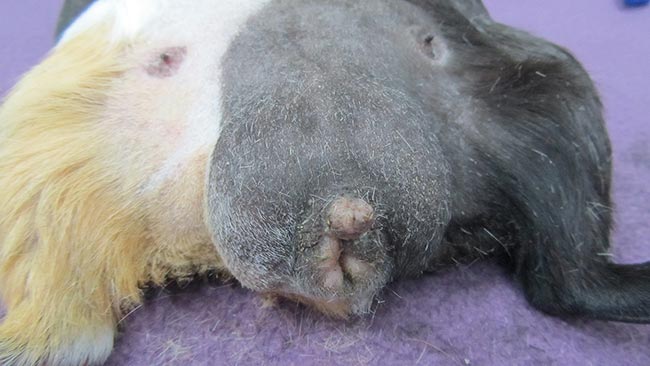
In females, the anogenital area is Y-shaped (also evident in immature females) with the urethral opening forming the branches of the Y – the vagina (a vaginal membrane closes the vagina and only opens at the time of oestrus, before parturition or in case of reproductive pathology) representing the vertical tail (Figure 3; Keeble, 2009).
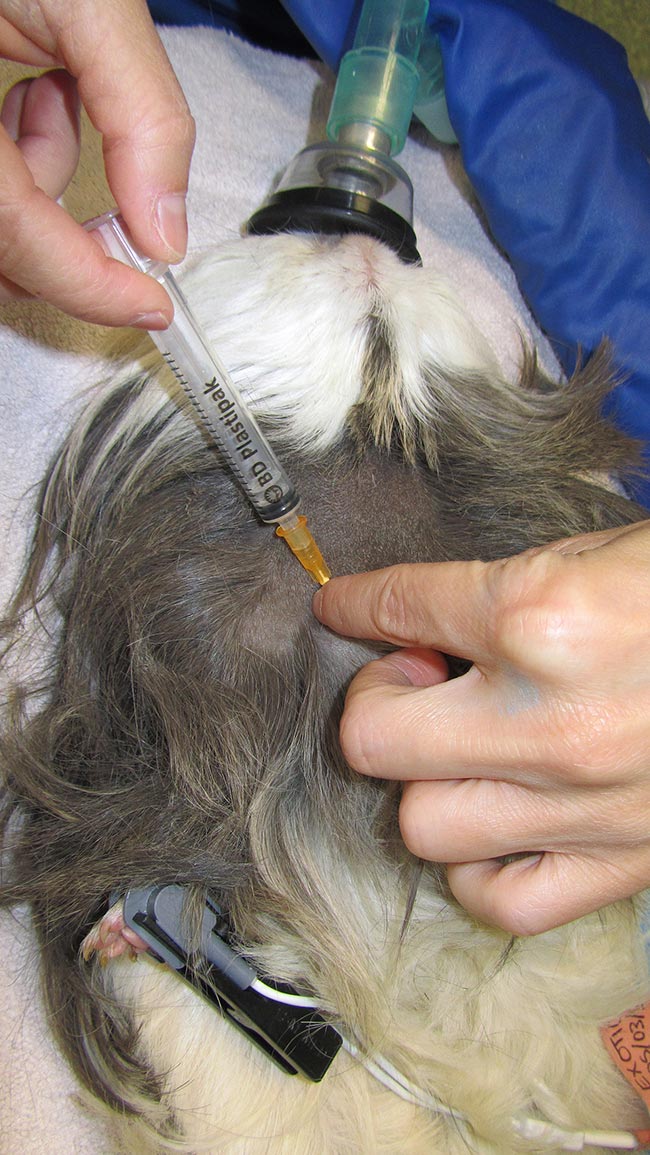
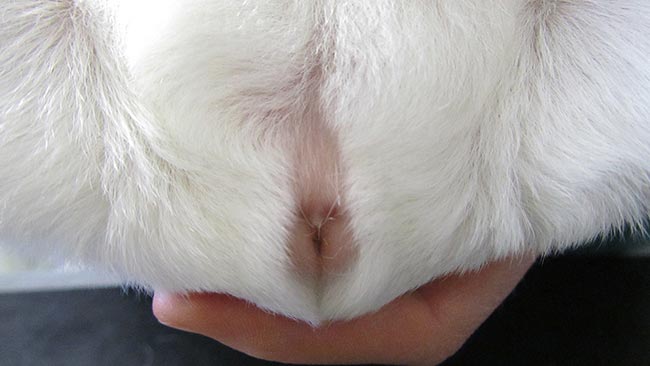
Both males and females have one pair of inguinal mammary glands.
Housing
Guinea pigs can be housed outdoors in a hutch with an enclosed run for exercise, or in a secure indoor enclosure.
Guinea pigs should not be exposed to extremes of temperatures (away from direct sunlight), humidity and draughts/wind, as these conditions may easily predispose them to health problems. The ideal temperature should be around 20°C to 22°C and humidity should be kept around 40% to 70% (Keeble, 2009). If the temperature increases to more than 27°C, guinea pigs can easily develop heat stroke.
Pens, cages and hutches can all be used to house guinea pigs, while aquaria are not recommended because they do not provide adequate ventilation and may increase the risk of developing respiratory infections. Stainless steel cages with a solid plastic bottom are generally used, as wire flooring may predispose to pododermatitis and leg injuries. Wood is not recommended as it may be chewed, get soaked in urine and is difficult to clean.
The minimum recommended floor space is 700cm2 per adult animal with 40cm high lateral cage walls. However, a large hutch (at least 100cm long × 50cm wide × 40cm high), raised off the ground (approximately 20cm), if outdoor with an attached run (150cm × 100cm at minimum), can be recommended for guinea pigs. Guinea pigs cannot jump or climb, so do not require much vertical space.
Plenty of suitable dust-free and absorbent bedding materials should be provided and may include shredded paper, newspaper, recycled paper pellets, wood shavings (not cedar or sawdust) and hay/straw (care of corneal injuries). This will allow for natural nesting and hiding behavioural expression and help prevent pododermatitis (Figure 4).
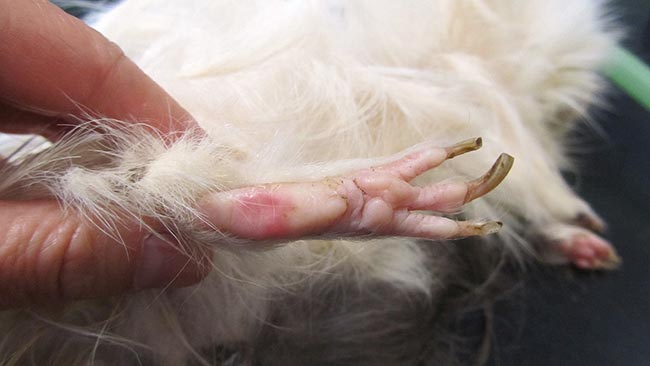
The substrate should be spot-cleaned daily and totally changed at least twice a week. Being prey species, these animals require plenty of hides and secure areas, such as tunnels, cardboard boxes, pipes or plastic tubes and blocked off draught-free areas, especially if housed outside.
Always provide plenty of safe toys, wooden blocks or pesticide-free natural tree branches to gnaw on. Enrichment items include toilet and paper towel rolls, untreated cardboard boxes, paper bags and safe toys specifically designed for guinea pigs, rabbits, large birds and cats (Johnson-Delaney, 2008).
Wooden blocks or untreated and pesticide-free branches, such as fruit trees, willow or poplar, can also be given to guinea pigs to gnaw on. Poisonous trees include cherry, plum, cedar and oleander (Keeble, 2009).
Diet
Guinea pigs are monogastric, grazing herbivores. They develop their dietary preferences very early in life and do not adapt easily to changes in type, appearance or presentation of their food and water (Quesenberry et al, 2012). It is, therefore, a good idea to expose them to small amounts of different types of commercial pellets and vegetables from a young age.
They mainly eat at night and perform coprophagy in the morning. Their diet should be high in fibre (12% to 16%), which is digested more efficiently than in rabbits (Cheeke, 1987). High fibre intake is necessary to ensure adequate chewing activity and promote tooth wear and gastrointestinal health. They must, therefore, have ad libitum access to good quality hay (Keeble, 2009). Clover and alfalfa hay should not be given to adults because their high calcium content predisposes to renal calcification (Yarto-Jaramillo, 2011).
A handful of a variety of leafy green vegetables twice a day and a small amount of fruit, without a high sugar content, should also be given and are very much enjoyed. These feed items are important to provide a good quality and balanced diet.
Commercial pelleted diets are preferred over mixes because they provide more fibres and nutrients, ensuring a better quality and balanced diet, and prevent selective feeding. Feeding pellets ad libitum is not recommended because guinea pigs will tend to prefer them to hay.
Guinea pigs lack the hepatic enzyme 1-gunolactone-oxidase responsible for converting glucose to ascorbic acid (vitamin C). Their inability to synthesise vitamin C is responsible for their absolute dietary requirement. If vitamin C is not supplemented in the diet, clinical signs of scurvy may arise, including anorexia, weakness, decreased mobility, stiffness, diarrhoea, skin lesions, petechiae, subcutaneous haemorrhage, teeth problems and increased susceptibility to secondary bacterial infections (Hollamby, 2009).
Guinea pigs require 10mg/kg to 30mg/kg of vitamin C daily, depending on their physiologic state, as tissue levels are only maintained for approximately four days. Cabbage, kale, dandelions, parsley, spinach, chicory, asparagus, green and red peppers, beet greens, broccoli, tomatoes, kiwi, red berries and oranges contain high levels of vitamin C, although may not be sufficient to daily requirements. Many of these vegetables, such as kale, cabbage, whole green pepper and parsley, also have high levels of calcium and oxalate; therefore, they should be fed in small amounts (Jenkins, 2010; Quesenberry et al, 2012).
Vitamin C tablets can be given by mouth (up to 10mg daily) or dissolved in drinking water at the rate of 1g per litre daily (or a quarter of a 1g tablet in 250ml of water). Vitamin C is unstable in the presence of light, so the water bottle should be covered and/or changed daily. Excess vitamin C is harmlessly excreted in the urine (Keeble, 2009). Commercial pelleted diets are often fortified with vitamin C, but storage can significantly reduce the vitamin content – approximately half of this content is lost within three months of opening, even if stored under optimal conditions.
Water should be provided fresh daily via a dropper bottle and/or bowls, which should be slightly raised or in an area unlikely to be soiled and walked into. Heavy ceramic bowls should also be used to avoid tipping and soiling (Figure 5).
The average food intake is 60g/kg to 70g/kg per day in adult animals and the average water intake is 100ml/kg to 200ml/kg (Keeble, 2009).
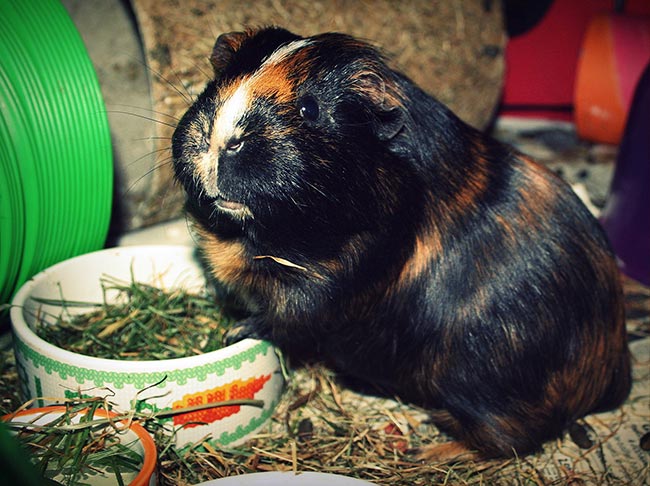
Handling
Guinea pigs do not tend to bite or respond aggressively to handling, but are easily stressed. If they feel in danger, they can either freeze or make a sudden movement to try to escape and may damage themselves. Use extra care in sick and debilitated animals, as guinea pigs can suffer from cardiorespiratory arrest secondary to the stress of restraint or following clinical procedures routinely performed in other species (Quesenberry et al, 2012).
Using small boxes/fabric pouches where they can hide can be useful to initially remove a guinea pig from a large enclosure (Figure 6).
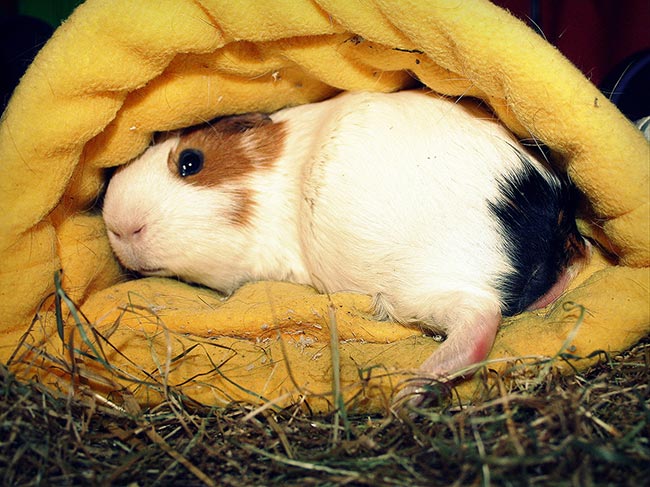
Many guinea pigs do not like being touched or stroked over the dorsal head area and will perform a thrusting motion to stop it. Always keep their back and rump supported, by holding the pectoral girdle/forelimbs in one hand and the hindlimbs with the other hand (Bament, 2012; Figure 7).
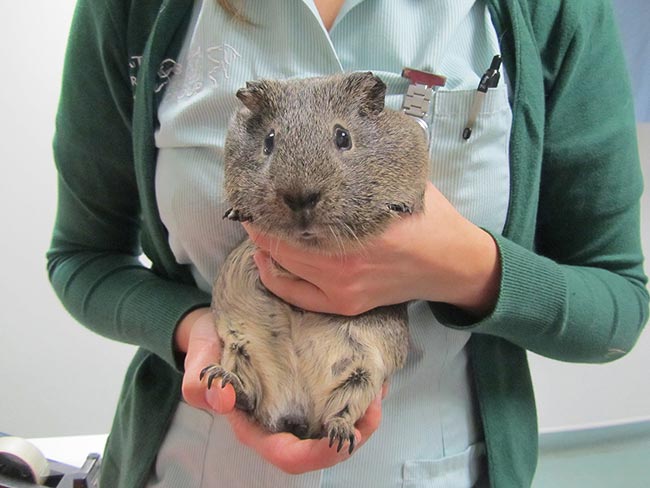
Guinea pigs generally do not like to be held on their back and will feel more at ease being kept the right way up with all feet on a horizontal surface. Placing the body lengthways along the handler’s arm, with the head tucked behind the elbow and the other hand holding its back, is a suitable restraint technique (Bament, 2012; Figure 8). The hindquarters should always be supported.
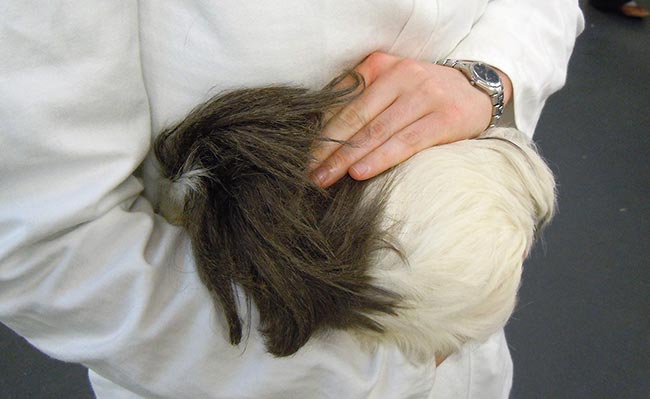
Vaccinations
Guinea pigs do not need any vaccinations; however, three or six-monthly check-ups are recommended.
Neutering
Neutering is recommended for all guinea pigs if opposite sexes are kept together. Entire males may fight and neutering may reduce these unwanted behaviours. Elective ovariohysterectomy in guinea pigs can be challenging due to anatomic features, such as long and thin uterine horns, fragile salpinges and short ovarian suspensory ligaments.
A surgical approach from the flank may be advantageous compared to the traditional ventral midline approach, allowing elective ovariectomy of young females (Capello, 2006).
References
- Bament W (2012). VN’s guide to guinea pigs: handling, nutrition, nursing, VN Times 12(10): 25-27.
- Capello V, Gracis M and Lennox AM (2005). Rabbits and Rodents Dentistry Handbook, Zoological Education Network, Lake Worth: 1-274.
- Capello V (2006). Flank approach to elective ovariectomy in guinea pigs, Exotic DVM 8(5): 33-37.
- Cheeke PR (1987). Rabbit Feeding and Nutrition, Academic Press, Orlando.
- Cox PG, Rayfiel EJ, Fagan MJ, Herrel A, Pataky TC and Jeffery N (2012). Functional evolution of the feeding system in rodents, PLoS ONE 7(4): e36299.
- Hollamby S (2009). Rodents: neurological and musculoskeletal disorders. In E Keeble and Meredith A (eds), BSAVA Manual of Rodents and Ferrets, BSAVA, Gloucester: 161-168.
- Jenkins JR (2010). Diseases of geriatric guinea pigs and chinchillas, Vet Clin North Am Exot Anim Pract 13(1): 85-93.
- Johnson-Delaney CA (2008). Exotic animal care – what veterinarians need to know about guinea pigs, Exotic DVM 10(3): 36-43.
- Keeble E (2009). Rodents: biology and husbandry. In E Keeble E and Meredith A (eds), BSAVA Manual of Rodents and Ferrets, BSAVA, Gloucester: 1-17
- Quesenberry KE, Donnelly TM and Mans C (2012). Biology, husbandry and clinical techniques of guinea pigs and chinchillas. In Quesenberry KE and Carpenter JW (eds), Ferrets, Rabbits and Rodents Clinical Medicine and Surgery (3rd edn), Elsevier Saunders, St Louis: 279-294.
- Yarto-Jaramillo E (2011). Respiratory system anatomy, physiology and disease: guinea pigs and chinchillas, Vet Clin Exot Anim 14(2): 339-355.
